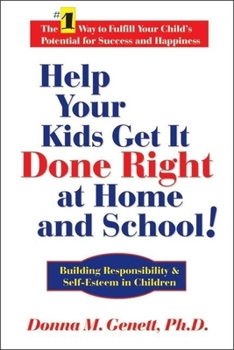Help Your Kids Get It Done Right at Home and School!: Building Responsibility & Self-Esteem in Children
Dr Donna M Genett packs an immediately applicable message that is guaranteed to drastically change the life of the reader and his or her children for the better. This description may be from another edition of this product.
Format:Hardcover
Language:English
ISBN:1884956459
ISBN13:9781884956454
Release Date:May 2005
Publisher:Quill Driver Books
Length:109 Pages
Weight:3.10 lbs.
Dimensions:0.6" x 5.6" x 8.3"
Customer Reviews
3 ratings
Help Your Kids Get it Done Right at Home and School!
Published by Thriftbooks.com User , 15 years ago
Love the book, easy reading not boring it was easy to comprehend. I bought it for my daughter and grandson. I wish it was available when my children were small. Thanks
Story that empowers you with tools you can use to help kids do better at school
Published by Thriftbooks.com User , 16 years ago
This is a story of two families - James' family is struggling to cope while Jones' family is having it easy. Why, what sets these two families apart? James sets out on a mission to find this out so as to help his family become as efficient as Jones' family. That's the story line and it is very well written - smooth reading, good humor, good people. Just as the story the tools that James learns from Jones are simple as well, though, powerful. Each tool/technique builds on previous tool(s)/technique(s) and is introduced, on need basis, to address a problem that James' family encounters on thier quest for betterment. All in all James & Joyce (wife) learn 6 techniques. The sequence for each one's introduction is as follows: Problem/Crisis - Technique - Application of Technique to resolve problem/crisis. So, not only techniques are introduced on a need basis, you are also shown thier application to dissipate the problem situation. Here are few of the problem/techniques from the book: Problem 1: Though kids are spending a lot of time doing their assignments and studying yet they are not doing well at school and are facing the prospect of being removed from participating in their favorite activities (example, soccer) Technique 1: Ensure that kids are understanding their assignments well as the reason for kids not performing well is may be they don't have the clarity on what exactly is expected of them on the assignment. So, this technique is about teaching students on how they can make sure that they understand the assignment. Okay, here it is. After teacher spells out the assignment the author suggests that the kids should paraphrase and repeat it back to the teacher to get confirmation. Problem 2: Kids start to do better at school, however, they are falling behind as they are not able to submit their assignments on time. What to do now? Technique 2: The problem here has to do with planning and estimation. So, here James suggests to buy (or make) big calendars and stick them to the wall, mark extra-curricular activities in one color, assignments in a different color, and social engagement in a different color and estimate the time it takes for a bigger assignment and based on that mark a start date for it and draw line from the start date to its due date to indicate that this has to be worked on each of those days. There are a few more details to this technique ... Problem 3: Kids now understand their assignments well and have gotten good at using calendar and are turning in thier assignment on time. Still to their surprise they get a C- on the biggest project of the year. Technique 3: Well, just as adults, kids can get on a tangent or get too engrossed in a detail and hence turn in something different from what the assignment was about. In our case the kid gets engrossed on the big cats while the assignment is about three countries countries she would like to visit and why. Here James suggests to have checkpoint to ensure kid
Chapters contrast different methods of building self-esteem in kids
Published by Thriftbooks.com User , 19 years ago
Identical twins James and Jones are back to present parents with a message reinforced by parable example. Here James notices Jones' kids achieve more and are happier than his own, more regimented routine kids. How is this to be remedied? Chapters contrast different methods of building self-esteem in kids using the parable as an easy example.






